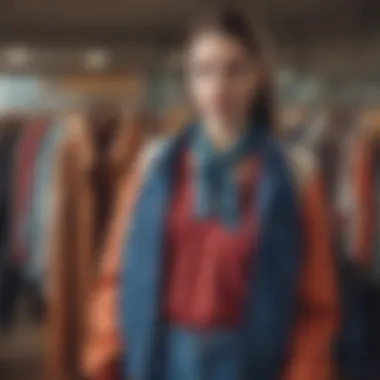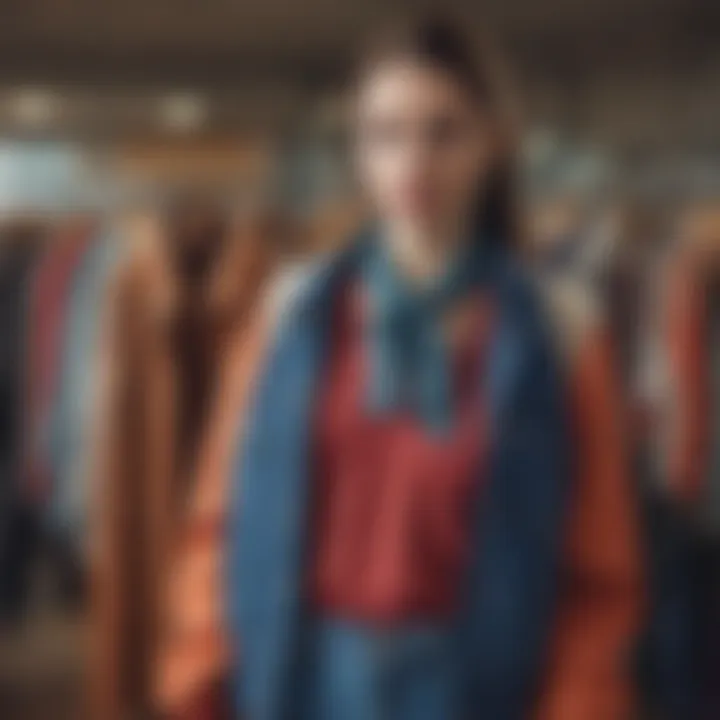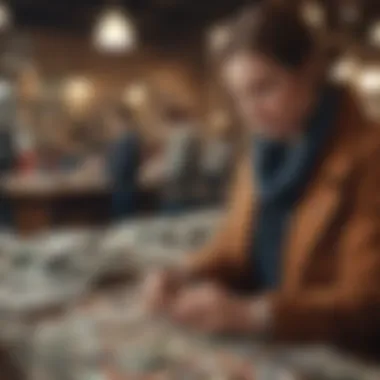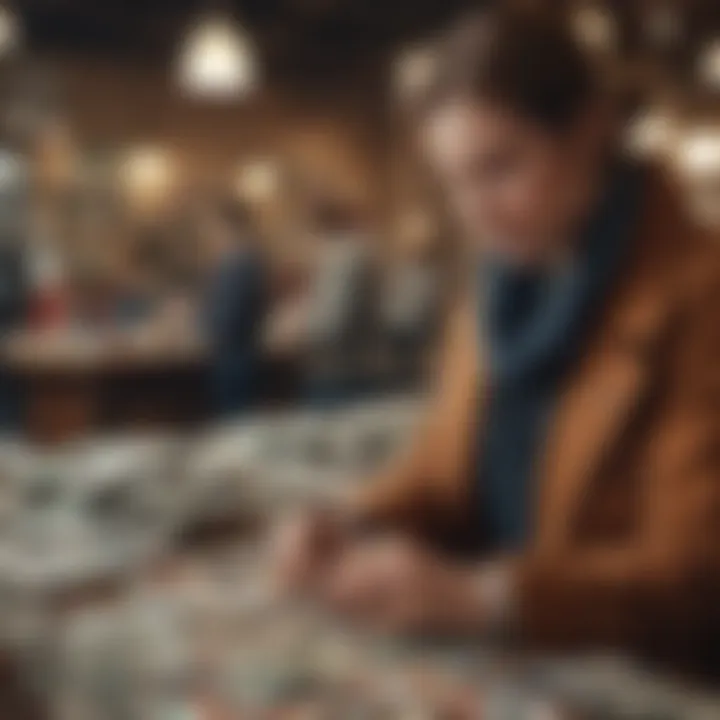Exploring ThredUp: Your Guide to Second-Hand Fashion


Intro
ThredUp has become a focal point in the realm of online second-hand fashion. This platform not only allows users to buy and sell clothing, but it also holds a mirror to changing consumer habits. The demand for sustainable fashion has surged, pushing platforms like ThredUp into the spotlight. In this article, we will explore the core aspects of ThredUp, providing a comprehensive overview of its operational mechanisms, advantages, and challenges in the context of the broader fashion marketplace.
Through a methodical analysis, we will dissect user experiences and financial considerations, further detailing how ThredUp aligns with contemporary trends in shopping behavior. This analysis serves as an essential resource for those looking to navigate the complexities of the second-hand fashion industry. We aim to highlight critical insights into ThredUp's business model, as well as the inherent opportunities and risks that come with engaging in this innovative platform.
Market Overview
Current Market Sentiment
The current sentiment surrounding the second-hand fashion market is notably positive. Many consumers are shifting their focus to sustainability, leading to increased interest in platforms like ThredUp. The appeal of unique fashion items at lower price points has captured a diverse demographic, ranging from budget-conscious shoppers to eco-conscious Millennials and Generation Z. The growth in awareness about the environmental impacts of fast fashion has become a significant driver of this sentiment.
Major Indices Performance
In assessing the broader implications, it's imperative to consider the impact of major stock indices. Companies involved in the resale market have shown resilience, even amid turbulent economic times. This behavior often reflects a healthier attitude towards thrift shopping.
Economic Indicators Analysis
Economic factors also play a role in the second-hand market's buoyancy. Metrics such as consumer spending, unemployment rates, and disposable income provide vital context. As economic conditions shift, ThredUp and its competitors could experience varied impacts based on these indicators. It's essential for investors to stay astute about how these elements interplay with the market landscape.
The current trend signifies a crucial pivot in consumer behavior, steering attention towards resale and sustainability.
Navigating the complexities of ThredUp becomes increasingly imperative for both users and investors. Understanding the operational framework, market dynamics, and broader economic context sets the stage for a fruitful exploration of the platform.
Prelude to ThredUp
The realm of fashion is undergoing significant transformation, and ThredUp embodies this shift towards sustainability and conscious consumption. Understanding ThredUp is essential for anyone looking to navigate the complexities of second-hand fashion. This platform not only facilitates buying and selling but also emphasizes environmental responsibility and economic feasibility. Through this section, we will dissect the platform's core dimensions, its historical context, and its implications for both consumers and investors.
Overview of the Platform
ThredUp offers a practical solution for individuals who are keen to buy or sell second-hand clothing. The interface is user-friendly, enabling a straightforward shopping experience that reduces the barriers often associated with thrift shopping. Users can explore a vast selection of pre-owned items, which range from high-end brands to everyday wear. Additionally, the platform allows sellers to declutter their wardrobes while potentially earning income from items that might otherwise remain unused.
The process begins with user registration, which is quickly followed by either listing items for sale or browsing through the extensive inventory available. The site boasts various filtering options, allowing users to locate specific items based on size, brand, or style. By integrating technology with sustainable practices, ThredUp positions itself as a forward-thinking marketplace in the fashion industry.
History and Background
ThredUp's inception challenges traditional retail norms by promoting circular fashion. Founded in 2009, the platform has seen significant growth and evolution. Its beginnings can be traced to a vision of creating a simple yet effective way for consumers to exchange clothing. Over the years, the platform has expanded its reach and services, making it a notable player in the second-hand market.
Reflecting broader trends in retail, ThredUp has ridden the wave of increasing consumer interest in sustainability. As concerns about fast fashion surge, this platform stands out by offering a viable alternative that aligns with the growing demand for ethical consumption. Since its launch, ThredUp has made strides in establishing partnerships with various brands and retailers, further solidifying its position within the industry. Its journey illustrates how second-hand marketplaces can reshape consumer behavior and challenge the conventional notions of fashion retail.
How ThredUp Works
Understanding how ThredUp operates is essential for anyone interested in the online second-hand fashion market. This section outlines important aspects related to the user experience, including registration, the process of selling items, and the mechanics of buying second-hand clothing. Gaining insight into these elements supports potential users in making informed decisions as they navigate this platform.
User Registration Process
Registering on ThredUp is quite straightforward. New users must provide basic information such as name, email address, and a password. This process ensures a personalized shopping experience and helps manage user interactions effectively. After registration, users can create a profile that may include preferences for clothing styles, sizes, and favorite brands.


Key Points:
- User-Friendly Interface: The registration process is designed to be simple and quick.
- Personalization: Users can tailor their profiles to enhance their shopping experience.
Listing Items for Sale
Selling on ThredUp is relatively easy, and the platform guides users every step of the way. Sellers need to prepare their items by following specific item condition guidelines. This is crucial in maintaining a quality inventory on the site. Once prepared, sellers can send clothes to ThredUp in a bag provided by the company. Sellers receive an offer from ThredUp based on the condition and market demand.
Item Condition Guidelines
These guidelines shape how sellers assess their clothes. Accurate assessment is vital as it influences the overall user experience. They must determine if the items meet ThredUp's standards, which focus on cleanliness and usability. ThredUp offers a clear table that outlines acceptable conditions ranging from
Benefits of Using ThredUp
ThredUp offers distinct advantages for both consumers and sellers in the realm of second-hand fashion. It appeals to those who seek sustainability, cost-effective options, and the convenience that online shopping affords. Understanding these benefits is essential for making informed decisions about purchasing or selling items on this platform.
Sustainability and Environmental Impact
One of the most significant benefits of using ThredUp is its contribution to sustainability. The fast fashion industry is often criticized for its detrimental impact on the environment. By purchasing second-hand items, consumers reduce their carbon footprint. Each piece of clothing bought on ThredUp helps keep clothing out of landfills. This is crucial, as textile waste contributes heavily to global pollution.
Additionally, ThredUp promotes a circular economy, where items are reused and recycled. The platform encourages users to think critically about their consumption habits. Purchasing second-hand is an effective way to combat overproduction, a rampant issue in the fashion industry. Many clothing items on ThredUp are still in great condition, waiting for new owners. This not only benefits the environment but also instills a sense of value in pre-owned garments.
Cost Savings for Consumers
ThredUp presents a remarkable opportunity for consumers to save money. Buying second-hand typically costs significantly less than purchasing new clothes. Many items are available at reduced prices, allowing shoppers to find high-quality brands without paying full retail prices. This price advantage can be especially appealing for budget-conscious fashion lovers.
Moreover, ThredUp often has sales and promotions that further enhance savings. From discounted items to occasional free shipping offers, users can benefit financially while expanding their wardrobe. Buying from ThredUp can also lead to unique finds that may not be available in traditional retail stores.
Convenience of Online Shopping
The convenience of online shopping is another prominent advantage of ThredUp. Shoppers can browse through thousands of items from the comfort of their own home. The platform is designed to be user-friendly, featuring search functionalities that allow users to filter items by size, brand, and category. This makes it easy to locate specific items quickly.
Furthermore, the shopping experience on ThredUp saves time. Instead of visiting multiple thrift stores or consignment shops, consumers can explore a vast inventory all in one place. With ThredUp's mobile app, shopping is even more accessible, allowing for purchasing on the go.
ThredUp transforms how we think about buying clothes, making it efficient, affordable, and environmentally responsible.
These benefits illustrate why ThredUp continues to gain traction among consumers. By understanding the importance of sustainability, cost savings, and convenience, users can maximize their experience while contributing to a better future for the fashion industry.
Challenges and Limitations
Understanding the challenges and limitations of ThredUp is crucial for any user, whether they are buyers or sellers. While the platform has revolutionized the second-hand fashion market, it comes with its unique set of hurdles that users must navigate. Recognizing these limitations will not only help potential users make informed decisions but also set realistic expectations regarding the entire process.
Shipping and Processing Times
One of the primary challenges faced by users of ThredUp involves shipping and processing times. Once a seller sends their items to ThredUp, there may be a considerable delay before they appear for sale on the platform. This delay can be frustrating, particularly for those eager to clear out their closets or to see their items listed. The shipping time alone can vary depending on the seller's location and ThredUp's warehouse capacity.
On average, it can take up to two weeks—or sometimes longer—for items to be processed and photographed. This timeline can lead to uncertainty for sellers who may prefer to list items quickly to capitalize on trends or seasonal sales.
Additionally, buyers might experience delays in receiving their purchased items. Once an order is placed, packaging and shipping must be accounted for. The customer’s location can significantly influence the total delivery time, complicating the casual shopping experience present in fast-fashion retail.


Seller Payout Structure
Another area of concern for sellers is the payout structure provided by ThredUp. The way sellers are compensated can often lack transparency. Unlike traditional consignment shops where negotiations may take place, ThredUp has a fixed payout system based on the item's resale value, quality, and whether it sells quickly or takes time to move. This can lead to disappointment if sellers feel their items are undervalued.
Sellers should also be aware of how long it may take to receive their earnings. Payments are generally processed after the items sell, which can lead to a lag in income. This structure may not align with the ambitions of those looking to earn money quickly from their closet cleanout.
In addition, ThredUp retains a portion of the sales price as a commission. This is typically between 20% to 90%, further complicating sellers' ability to gauge their total earning potential accurately.
Limited Brand Options
While ThredUp aims to curate a diverse range of second-hand clothing, the selection may appear limited in certain brands or styles. High-demand or luxury brands, for instance, may be less prevalent, impacting buyers seeking specific items. This limitation can present an obstacle for consumers who are specifically looking for high-fashion brands or contemporary pieces.
Another point to consider is that the available inventory updates frequently but is dependent on the items that sellers choose to send in. This means that stock availability can be sporadic. Users might not find what they are looking for, which can lead to frustration and dissatisfaction.
Consumer Experiences
Understanding consumer experiences is crucial to comprehending ThredUp's position within the second-hand fashion market. As potential buyers and sellers, it is essential to learn how users interact with the platform. This section delves into user reviews and testimonials, as well as case studies of individual shoppers. By doing so, it highlights the advantages, challenges, and overall satisfaction associated with using ThredUp.
User Reviews and Testimonials
User reviews serve as a microcosm of the overall consumer experience on ThredUp. These reviews are often a mixture of positive and negative insights, offering potential users a realistic view of what to expect.
Some users praise the quality of the items received. They often note how ThredUp offers a wide range of clothing brands at significantly lower prices compared to traditional retail stores. Satisfied shoppers frequently mention the ease of browsing and the user-friendly interface.
However, other reviews may indicate issues such as shipping delays or discrepancies between advertised condition and actual item quality. Negative experiences can hinder trust in the platform and affect future purchase decisions. Such testimonials are essential for drawing attention to areas needing improvement. This feedback also highlights the need for ThredUp to maintain transparency in its listings and uphold a stringent quality control process.
Key Points from User Reviews:
- Quality of Items: Many users report satisfaction with the quality of clothes they receive.
- Price Point: Affordable pricing makes ThredUp an attractive shopping destination.
- Shipping Concerns: Delays and issues arise from time to time, impacting customer satisfaction.
These insights provide invaluable information for potential shoppers and investors. They must evaluate consumer sentiment to make informed decisions about engaging with the platform.
Case Studies of ThredUp Shoppers
Analyzing individual case studies offers more profound insights into how different users utilize ThredUp. For instance, one shopper, Emily, shared her experience searching for sustainable fashion options. She found it challenging to locate items fitting her style in her local retail stores. After discovering ThredUp, Emily began selling her own unused clothes, promoting a more sustainable wardrobe. Her satisfaction stemmed not just from original savings but the eco-friendly aspect of her choices.
Conversely, another user, Mark, focused on shopping for children's clothing. He appreciated the significant cost benefits, especially given the fast growth of kids. Yet he also emphasized the importance of thorough browsing to locate suitable items. Mark stressed that the user interface made his shopping experience seamless but that he encountered instances where the descriptions did not align with the received items’ conditions.
Insights from Case Studies:
- Diverse Needs: Users engage with ThredUp for various reasons, from sustainability to cost savings.
- Personal Stories: Real-life experiences illustrate the multifaceted nature of using this platform.
- Challenges Persist: Consumers face challenges that can affect their overall experience, highlighting the need for continuous improvement on ThredUp’s part.
ThredUp's Role in the Fashion Industry
ThredUp has emerged as a significant player in the fashion industry within the context of an evolving consumer landscape. As more individuals become aware of sustainable practices, the demand for second-hand options like ThredUp is on the rise. This section describes how ThredUp fits into the broader fashion ecosystem and why its emergence is crucial for both consumers and investors alike.
The Rise of Second-Hand Marketplaces


The growth of second-hand marketplaces is indicative of shifting consumer preferences. ThredUp typifies this shift by providing an accessible online platform for purchasing and selling used clothing. In recent years, consumers have increasingly gravitated towards thrift shopping as a means to find unique pieces while also being mindful of environmental impact.
Consumers are no longer just interested in new items, but are actively seeking ways to minimize their carbon footprints. Studies show that purchasing second-hand clothing can reduce one's carbon footprint significantly compared to buying new garments. This awareness has spurred interest in platforms like ThredUp, which promote sustainable consumption through their business model.
Some key elements contributing to the rise of second-hand marketplaces include:
- Affordability: Second-hand items are often sold at a considerable discount, making them attractive to budget-conscious shoppers.
- Unique Finds: ThredUp offers a variety of items that are not available in typical retail, appealing to consumers who want distinctive clothing.
- Sustainability Concerns: As more individuals become conscious of waste in the fashion industry, the appeal of second-hand shopping spikes.
All these factors come together to articulate the growing relevance of platforms like ThredUp in the fashion industry.
Impact on Traditional Retailers
The presence of ThredUp and similar platforms has begun to disrupt traditional retail. Many conventional retailers are struggling as consumers increasingly favor the second-hand market. This change signifies a shift in how clothes are bought and sold. Retailers must adapt to a landscape where second-hand options take precedence.
Some notable impacts on traditional retailers include:
- Competition for Sales: With the rise of ThredUp, many retailers face declining sales in certain categories, particularly in casual and fast-fashion segments.
- Changing Target Demographics: ThredUp appeals strongly to younger, environmentally conscious consumers. This audience can no longer be counted on to patronize traditional retailers as they seek ethical and sustainable shopping options.
- Shift in Inventory Management: Retailers are beginning to incorporate sustainability into their models. Some stores have started their second-hand initiatives, such as reward systems for recycling clothes or launching consignment brands.
The challenge for retailers is to rethink their value proposition in light of user preferences favoring sustainable options.
Investment and Future Trends
Understanding the investment and future trends surrounding ThredUp is essential for those looking to engage with the platform from a financial perspective. This section underscores the potential avenues for profitability and growth that ThredUp presents to investors. The concept of second-hand fashion is not just a fleeting trend; it is increasingly being recognized as a viable segment within the broader retail landscape. Shifts in consumer behavior towards sustainability and cost-efficiency make this space particularly appealing.
ThredUp as an Investment Opportunity
Investing in ThredUp offers potential for both short-term gains and long-term financial growth. As online thrift store sales continue to surge, ThredUp stands out with its unique business model. It provides an efficient platform for individuals to both buy and sell pre-owned clothing, tapping into a market that values sustainability.
Factors to consider when evaluating ThredUp as an investment include:
- Market Demand: The demand for second-hand items is rising, particularly among younger consumers who prioritize environmental conscientiousness.
- Revenue Growth: ThredUp has shown strong revenue growth in recent years. This trend indicates a favorable direction for future financial performance.
- Platform Development: Continuous improvement of user experience and logistical capabilities contributes to customer satisfaction and retention.
Investors should keep an eye on how ThredUp leverages its brand loyalty and expands its user base to enhance profitability. The ability of ThredUp to remain competitive in a crowded market will be crucial for its long-term success.
Potential Growth Areas in the Business
ThredUp's future growth potential is multifaceted, with several key areas that could catalyze expanding its influence in the fashion industry. Identifying these areas can provide insight into where the company is headed.
- International Expansion: Currently, ThredUp mainly serves the United States. Expanding operations into international markets could substantially increase its customer base.
- Product Variety: By diversifying inventory to include more brands, styles, and categories such as men's and children's clothing, ThredUp may attract a wider audience.
- Technological Advancements: Investment in artificial intelligence and machine learning could enhance the user experience by improving product recommendations, streamlining the shopping process, and elevating the efficiency of inventory management.
"The second-hand market is expected to continue to grow at an unprecedented rate, reinforcing its position as a serious competitor to traditional retail."
Closure
In this article, we have explored the various dimensions of ThredUp, focusing on how it operates within the online second-hand fashion market. The significance of this topic cannot be overstated, especially considering the rising consumer interest in sustainable practices. ThredUp exemplifies a shift towards eco-conscious shopping, making second-hand clothing more accessible. It not only presents an alternative to traditional retail but also promotes the recycling of fashion items, reducing waste in the industry.
Recap of Key Points
Throughout our exploration, several key points have emerged:
- Operational Structure: ThredUp functions as a consignment and thrift store, streamlining the buying and selling processes for second-hand clothing.
- User Experience: The platform prioritizes user-friendliness, allowing effortless navigation through its features.
- Economic and Environmental Impact: By fostering a marketplace for recycled fashion, ThredUp plays a significant role in reducing the environmental footprint associated with clothing production.
- Challenges & Limitations: There are practical challenges such as shipping times and payout structures that potential users should consider before engaging.
- Future Prospects: With increasing interest in sustainable fashion, ThredUp appears well-positioned for growth, both within its operations and its investment potential.
Final Thoughts on ThredUp
ThredUp presents a unique opportunity for individuals who wish to engage in second-hand fashion ethically and economically. With its innovative approach, ThredUp has positioned itself as a leader in the online second-hand market, and its impact will likely continue to grow in the years to come. The decisions consumers make regarding ThredUp can cumulatively affect not just personal finance but also the broader implications of fashion sustainability.



